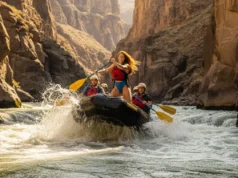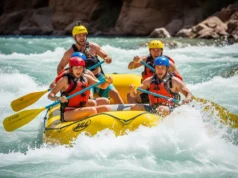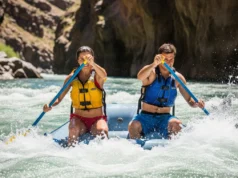In this article
The quiet glide of your raft across a calm pool between rapids. The crew is resting, but a gentle crosswind begins to push the bow offline. Instead of a jarring, momentum-killing pry stroke, you execute a seamless, silent correction that brings the boat back on course without a ripple of lost speed. This is the art of the J-stroke, and this guide will transform it from a confusing concept into a core part of your wilderness instinct and paddle guiding technique.
Mastering a paddle stroke like this is about more than just mechanics; it’s about translating knowledge into an intuitive feel for the water. It’s the journey from being a navigator who gives instructions to becoming an integral part of the river’s flow. We’ll explore the physics that make your raft want to turn, break down the raft-specific “Modified J-Stroke” step-by-step, discover when to use this tool of finesse versus a more powerful stroke like a stern draw, and master the biomechanics that will let you paddle powerfully for a lifetime, injury-free. By the end, you won’t just know how to do a single corrective stroke; you’ll understand the strategy behind steering, empowered to choose the right tool for the right moment with instinct and confidence.
Why Does a Raft Turn? Understanding the Physics of Control
Before you can correct a turn, you have to understand why it happens in the first place. Every single time you put a paddle in the water for propulsion, you’re introducing forces that create resistance and want to turn the boat. This isn’t a flaw in your technique; it’s a fundamental principle of physics that every paddler must constantly manage. It’s the “why” behind every corrective stroke in your arsenal.
What is “Inherent Yaw” and Why Does It Happen?
“Yaw” is simply the natural tendency of a paddlecraft to turn away from the side where a stroke is applied. Think of your raft’s centerline as its spine. Any force you apply on one side of that spine will cause the boat to pivot. The reason is simple: the force from your paddle is applied at a distance from the raft’s central pivot axis, creating a turning moment, or leverage. As the guide in the stern, you are positioned farthest from this central pivot point. This gives your stroke the greatest leverage, making you the most significant turning influence on the boat. It’s this physical reality that makes the raft guide primarily responsible for steering and keeping the raft on its line.
Several factors can amplify this yaw. A paddle shaft that isn’t perfectly vertical during your forward stroke will have a slight sweeping component, pushing the stern sideways and turning the bow. Likewise, an overly long stroke that follows the curve of the raft’s outside tube past your body functions more like a Forward Sweep, inducing an even greater turn. The goal of a forward stroke isn’t to pull water; it’s to “plant” the paddle blade in a fixed spot and pull the boat past it. Your paddle is a lever, and the water is your fulcrum. Any energy spent making the blade sweep or splash is energy not spent moving the boat forward. Now that we understand the problem—the inevitable turn—let’s dissect the most nuanced and efficient solution for calm water conditions. For a foundational, textbook-style explanation of these principles, check out this excellent resource on fundamental strokes and maneuvers from Frostburg University’s rafting course.
Pro-Tip: To feel your raft’s pivot point, have your crew stop paddling in calm water. Take a single, gentle forward stroke and feel where the boat seems to hinge. It’s often just in front of the center of the raft. Understanding this point intuitively will make all of your steering strokes more precise.
How Do You Perform the Raft-Specific “Modified J-Stroke”?
Let’s get one thing straight: the “J-stroke” you use in a raft is fundamentally different from the classic J-stroke perfected by canoeists using a paddle without a T-grip. In rafting, the term is a bit of a misnomer. What we’re actually executing is a compound stroke—a seamless blend of a forward stroke that flows directly into a light stern pry or rudder stroke. It’s a single, fluid motion designed for efficiency and control when you’re the only one paddling.
What are the Mechanics of a Forward Stroke into a Pry?
This stroke is best understood in three distinct but connected phases.
Phase 1: The Catch. This is your setup. A powerful stroke starts with your core strength. Rotate your torso to “face the work,” reaching forward to plant the paddle blade fully and vertically in the water. Your shaft hand should guide the paddle, while your T-grip hand drives it. The key is to get the blade buried before you apply any power. This ensures you’re grabbing solid, undisturbed water.
Phase 2: The Power Phase. The power comes from the unwinding of your torso. With solid foot placement—perhaps a foot locked between a thwart and the tube for a strong foot brace—use your large core and leg muscles to pull the raft forward, past the planted paddle. Your arms should act as linkages, like steel struts, transferring the power generated by your body’s rotation. Don’t pull with your arms; pull with your body. The path of the blade should travel in a straight line, parallel to the raft’s centerline, using the power face of the blade for propulsion.
Phase 3: The Correction. Here is where the magic happens. As the paddle blade approaches your hip, the propulsive phase ends and the corrective phase begins. You transition your top (T-grip) hand to a “thumb-up” wrist position, which changes the blade angle so that the back face is now pressing against the water. Apply gentle outward pressure, prying the stern of the raft away from your paddle. The path of the blade looks less like a classic “J-shape” and more like a “check-mark shape.” This light, subtle pry is just enough to counteract the yaw from the power phase, keeping you on a straight line.
Pro-Tip: For a more solid corrective pry, you can leverage the paddle shaft against your hip or the raft’s tube. This shaft position creates a stronger fulcrum, allowing you to move the heavy stern with less muscular effort and more precise control.
The goal is finesse. The corrective pry must be light enough that it doesn’t kill the forward momentum you just generated. Executing the stroke is one thing, but knowing when to use it—and when to choose a more powerful alternative—is the mark of an expert guide. This technique is one of many listed in the American Canoe Association’s Paddle Instructor Criteria, validating its place in a complete skillset. It’s a specialized tool, distinct from the other foundational techniques you should be mastering other basic rafting paddle strokes like the pure pry and draw.
When Should a Guide Use the J-Stroke vs. Other Power Strokes?
Choosing the right stroke is about reading the water and understanding your objective. A tool designed for preserving momentum has a very different application than one designed for immediate, powerful control. Your strategic decision-making must adapt as the river’s character changes, from flat water to technical rivers.
How Does Stroke Selection Change Across Whitewater Classes?
Your choice of stroke directly impacts the raft’s momentum, efficiency, and maneuverability. A good raft guide has a full toolbox and knows which tool to pull out for different rafting situations, from calm moving water to big water rapids with violent waves.
| Stroke Name | Primary Use | Ideal Water Class | Effect on Momentum |
|---|---|---|---|
| Modified J-Stroke | Efficiency | Class I-II | Preserves |
| Stern Pry | Power | Class III-V | Kills |
| Stern Draw | Power | Class III-V | Kills |
Class I-II (Efficiency is Key): In calm, moving water or in a strong tailwind, your primary challenge is maintaining a straight line and conserving energy. The Modified J-stroke is the undisputed king here. It allows you, the guide, to propel the raft during solo paddling while the crew rests, making subtle corrections without the constant braking effect of a pure pry stroke. This is the domain of finesse, where preserving every ounce of forward momentum is paramount.
Class III (Dynamic Steering): As the water gets bigger and river features like waves, holes, and tight eddy lines become critical, your priorities shift. The need for decisive, powerful turning increases dramatically. Here, the subtle Modified J-stroke is largely replaced by a toolbox of “pure” strokes. A strong Stern Pry or a hefty Draw Stroke gives you the immediate, powerful course correction required to catch an eddy or pivot sharply around an obstacle. In this environment, the loss of forward momentum is an acceptable trade-off for absolute control.
Class IV-V (Absolute Control): In high-stakes whitewater, finesse is a liability. The Modified J-stroke is completely ineffective. Survival depends on aggressive, powerful, and precise maneuverability. To move the raft’s immense mass with absolute authority, or to set a correct ferry angle in a powerful current, guides rely on powerful pry and draw strokes. These are often used in combination with coordinated raft commands for the paddle crew like “Right side forward, left side back!” This is about applying overwhelming force to change the raft’s angle and position instantly.
Choosing the right stroke is critical, but none of them are effective if your technique leads to fatigue or injury. Let’s build a foundation for a long and powerful paddling career.
How Can You Master the J-Stroke Without Risking Injury?
A sustainable stroke is a powerful stroke. The best guides on the river aren’t necessarily the strongest; they’re the most efficient. They’ve connected proper technique directly to injury prevention, allowing them to perform at a high level day after day, year after year. This means understanding how your body is designed to generate power.
What is the Kinetic Chain and How Does it Prevent Common Injuries?
A powerful stroke doesn’t start in your arms; it starts with your feet. The “kinetic chain” is the concept that a proper stroke begins with your feet braced against the raft, travels up through your legs and knees, is driven by the hips, and is amplified by the rotation of your core and torso. This power is finally channeled through your shoulders and arms into the paddle. Expert paddlers generate power from their torso rotation, while novices tend to “arm-paddle,” relying on smaller, more vulnerable shoulder muscles. Your body position is key: sit or kneel tall with an engaged core and strong leg bracing to allow for maximum rotation. Your arms should act as struts, simply transferring the immense power of your core, not creating it.
“Arm-paddling” is the number one cause of common injuries like rotator cuff strains and shoulder impingement. Similarly, gripping the paddle in a “death grip” leads to strain on the wrist/forearm and elbow tendonitis; practice loosening your grip to reduce stress. A failure to engage your core forces the rotational work onto your lumbar spine, leading to chronic back injury. For raft guides, who often paddle on the same side for an entire trip, it’s critically important to alternate paddling sides daily or even mid-trip to prevent muscular imbalances and overuse injuries. The scientific evidence laid out in this biomechanical analysis of the paddle stroke from the National Institutes of Health supports this core-centric approach. Further Research on injuries in whitewater kayaking, while focused on a different craft, confirms that the shoulder is the most vulnerable joint, reinforcing the need for proper biomechanics.
By combining an understanding of river dynamics with your own body’s mechanics, you build a truly sustainable and powerful paddling practice.
Conclusion
The “J-stroke” we use on a raft is a specialized tool, a Modified J-Stroke that blends a forward stroke with a light stern pry. It’s a masterclass in efficiency and momentum-preservation, making it the ideal choice for Class I-II water or the calm pools between rapids. As the river’s power grows, a guide’s strategy must shift from the finesse of the J-stroke to a toolbox of powerful pure strokes like the pry and draw, which provide immediate and absolute control. No matter the stroke, a sustainable, injury-free technique always relies on torso rotation and core engagement, not arm strength. This protects your shoulders, wrists, and back, ensuring a long and healthy career on the water.
Continue to build your river instinct by exploring our complete library of whitewater rafting technique guides and safety protocols.
Frequently Asked Questions
What is the difference between a J-stroke and a pry stroke?
A pry is a pure steering stroke where you plant the paddle and leverage it against the raft to push the stern away. A modified J-stroke is a compound stroke that combines a forward propulsion stroke with a light pry at the end. The J-stroke aims to maintain momentum while correcting course, whereas a pry is used for powerful, immediate turning, often at the cost of momentum.
Why is the rafting J-stroke different from the canoe J-stroke?
The key difference is blade orientation and wrist position. A classic canoe J-stroke, part of a family of strokes including the C-stroke and Canadian stroke, uses the same power face of the blade for both parts of the stroke (with a “thumb-down” wrist roll). The raft’s modified J-stroke switches to the back face of the blade for the corrective pry (with a “thumb-up” orientation). This difference comes from the raft’s immense inertia, which requires a more powerful and mechanically simpler corrective action than the subtle pressure used on a responsive canoe.
Is the J-stroke effective in strong whitewater?
No, the subtle, momentum-preserving J-stroke is largely ineffective and inappropriate for strong whitewater (Class III and above). In powerful currents, guides must use aggressive and decisive strokes like the stern pry and draw to control the raft’s position and angle.
Can you do a J-stroke with a T-grip paddle?
Yes, the modified J-stroke used in rafting is designed specifically for a T-grip paddle. The T-grip provides the necessary leverage and control to execute the forward stroke and transition smoothly into the corrective pry at the end.
Risk Disclaimer: Whitewater rafting, kayaking, and all related river sports are inherently dangerous activities that can result in serious injury, drowning, or death. The information provided on Rafting Escapes is for educational and informational purposes only. While we strive for accuracy, the information, techniques, and safety advice presented on this website are not a substitute for professional guide services, hands-on swiftwater rescue training, or your own critical judgment. River conditions, including water levels, currents, and hazards like strainers or undercut rocks, change constantly and can differ dramatically from what is described on this site. Never attempt to navigate a river beyond your certified skill level and always wear appropriate safety gear, including a personal flotation device (PFD) and helmet. We strongly advise rafting with a licensed professional guide. By using this website, you agree that you are solely responsible for your own safety. Any reliance you place on our content is strictly at your own risk, and you assume all liability for your actions and decisions on the water. Rafting Escapes and its authors will not be held liable for any injury, damage, or loss sustained in connection with the use of the information herein.
Affiliate Disclosure: We are a participant in the Amazon Services LLC Associates Program, an affiliate advertising program designed to provide a means for us to earn advertising fees by advertising and linking to Amazon.com. As an Amazon Associate, we earn from qualifying purchases. We also participate in other affiliate programs and may receive a commission on products purchased through our links, at no extra cost to you. Additional terms are found in the terms of service.





